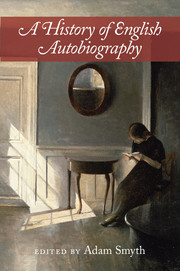Book contents
- Frontmatter
- Dedication
- Contents
- List of contributors
- 1 Introduction: The range, limits, and potentials of the form
- PART 1 AUTOBIOGRAPHY BEFORE ‘AUTOBIOGRAPHY’ (CA. 1300–1700)
- PART 2 RELIGION, GENDER, THINGS (CA. 1700–1800)
- 8 Structures and processes of English spiritual autobiography from Bunyan to Cowper
- 9 ‘Written by herself’: British women's autobiography in the eighteenth century
- 10 The lives of things: Objects, it-narratives, and fictional autobiography, 1700–1800
- 11 Empiricist philosophers and eighteenth-century autobiography
- PART 3 THE MANY NINETEENTH CENTURIES (CA. 1800–1900)
- PART 4 RELATIONAL LIVES AND FORMS OF REMEMBERING (CA. 1890–1930)
- PART 5 KINDS OF COMMUNITY (CA. 1930-CONTEMPORARY)
- Index
- References
8 - Structures and processes of English spiritual autobiography from Bunyan to Cowper
from PART 2 - RELIGION, GENDER, THINGS (CA. 1700–1800)
Published online by Cambridge University Press: 05 March 2016
- Frontmatter
- Dedication
- Contents
- List of contributors
- 1 Introduction: The range, limits, and potentials of the form
- PART 1 AUTOBIOGRAPHY BEFORE ‘AUTOBIOGRAPHY’ (CA. 1300–1700)
- PART 2 RELIGION, GENDER, THINGS (CA. 1700–1800)
- 8 Structures and processes of English spiritual autobiography from Bunyan to Cowper
- 9 ‘Written by herself’: British women's autobiography in the eighteenth century
- 10 The lives of things: Objects, it-narratives, and fictional autobiography, 1700–1800
- 11 Empiricist philosophers and eighteenth-century autobiography
- PART 3 THE MANY NINETEENTH CENTURIES (CA. 1800–1900)
- PART 4 RELATIONAL LIVES AND FORMS OF REMEMBERING (CA. 1890–1930)
- PART 5 KINDS OF COMMUNITY (CA. 1930-CONTEMPORARY)
- Index
- References
Summary
‘Spiritual autobiography’ was not a label that eighteenth-century writers, editors, or readers of religious life-writing would have recognised. The predominant term for narratives written in the first person and detailing one's spiritual development in the context of life events was ‘experience’. Such experiences did not fit into a single category in terms of form, genre, physical appearance, or mode of circulation. An experience might appear as a duodecimo pamphlet of thirty-six pages (like John Newton's 1816 edition of William Cowper's Adelphi) or as a serial issued over the course of years, such as John Wesley's Journal. It might be produced by a tract society intended for mass distribution and priced accordingly, like the exemplary life story of the child Cartaret Rede, which was ‘faithfully taken from her own mouth’ (Rede 1760, title page). It might not be printed at all: the carefully preserved autobiographical narrative of Mary Steele in the archive of The Angus Library, Oxford, remained virtually unknown until its publication in 2011. Even within a single work, manuscript or printed, a narrative of religious experience was often a composite text. It was common to weave together biographical narrative with personal testimony, diary entries, letters, and prayers, and to intersperse personal expressions of religious feeling (which might themselves be composed out of hymns and Scripture) with editorial comments.
Patterns for spiritual autobiography
Recognising the complexity of the term ‘spiritual autobiography’ and the varied narrative practices contained within it problematises two influential twentieth-century conceptualisations of the practice. The first of these is ontological in that it understands autobiography as a technology for constructing individualised patterns for narrating being. The second is structural, and is known as the morphology of conversion. The first is articulated by Patricia Meyer Spacks, according to whom ‘[t]he crucial literary problem of autobiography is to articulate a significant form for the relative incoherence of human experience’ (Spacks 1976, 434). Spiritual autobiography is unique among autobiographical forms for being able to avoid that fundamental ontological difficulty because God provides the form. The writer cannot be held responsible for the pattern of the narrative they present. More than that: they cannot even understand the shape of the life they are representing until it is written.
- Type
- Chapter
- Information
- A History of English Autobiography , pp. 103 - 118Publisher: Cambridge University PressPrint publication year: 2016
References
- 2
- Cited by

